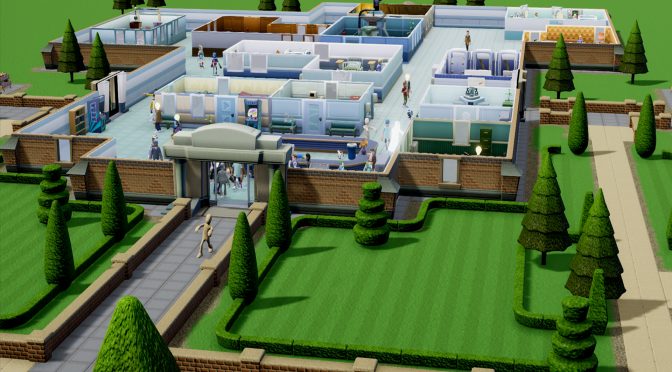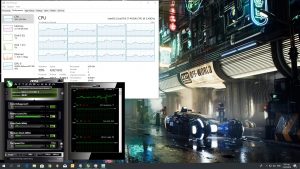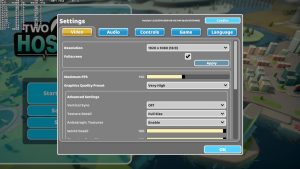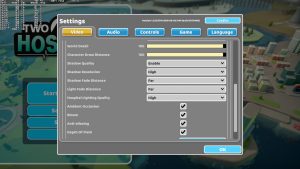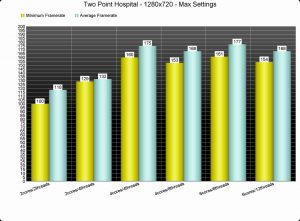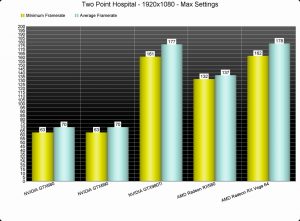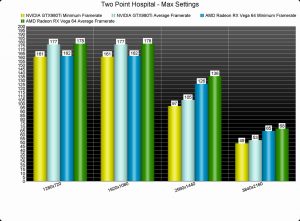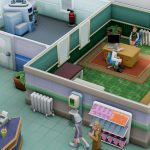Two Point Hospital, the spiritual successor to Theme Hospital, has just been released on the PC. Two Point Hospital will see players take on the role of Hospital Administrator where a mantra of build, cure and improve will be necessary on the journey to hospital management greatness. SEGA has provided us with a review code so it’s time to benchmark this medical simulator and see how it performs on the PC platform.
For this PC Performance Analysis, we used an Intel i7 4930K (overclocked at 4.2Ghz) with 8GB RAM, AMD’s Radeon RX580 and RX Vega 64, NVIDIA’s GTX980Ti and GTX690, Windows 10 64-bit and the latest version of the GeForce and Catalyst drivers. NVIDIA has not included any SLI profile for this game, meaning that our GTX690 performed similarly to a single GTX680.
Two Point Studios has implemented a few graphics settings to tweak. PC gamers can adjust the quality of Textures, World Detail, Character Draw Distance, Shadow Resolution, Shadow Fade Distance, Light Fade Distance and Hospital Lighting. There are also options to enable/disable Anisotropic Textures, Ambient Occlusion, Bloom, Anti-aliasing and Depth of Field. Oh, and PC players can increase the framerate cap up to 300fps.
In order to find out how the game performs on a variety of CPUs, we simulated a dual-core and a quad-core CPU. And we are happy to report that even our simulated dual-core system was able to provide a smooth gaming experience. We did notice some performance differences between our simulated dual-core and our six-core systems, however all systems were running the game with more than 100fps at 1080p on Max settings. Furthermore, Two Point Hospital is one of the few games that does not benefit at all from Hyper Threading (in fact we noticed a slightly worse performance when Hyper Threading was enabled).
Two Point Hospital also does not require a high-end GPU as even our GTX680 was able to provide a smooth 60fps experience at 1080p. Of course we are not really surprised by this kind of performance as the game does not really push the graphical boundaries of what isometric/top-down games can achieve. Still, it’s good knowing that this latest medical simulator can run on a vast range of PC configurations.
Two Point Hospital is also a game that seems to run great on both NVIDIA’s and AMD’s graphics cards. At 1440p both our GTX980Ti and our AMD Radeon RX Vega 64 were able to offer a smooth gaming experience. In 4K, though, our GTX980Ti was unable to offer a constant 60fps experience. On the other hand, our AMD Radeon RX Vega 64 was able to run the game with a minimum of 65fps and an average of 68fps.
Graphics wise, Two Point Hospital is exactly what Theme Hospital would look like in 3D. Two Point Studios has kept the game’s art style intact, and everything feels just like you remember it from those 2D days. As said, the game does not push the visuals of isometric games, however it looks really cute. It’s really pleasing to the eye and is colourful (which is a nice change from all those games that lack a variety of colours).
All in all, Two Point Hospital works like a charm on the PC. We did not witness any crashes, everything works perfectly fine with the mouse, and the game does not require a high-end system in order to be played (it is also protected by Denuvo and we did not experience any stutters or performance abnormalities).
Enjoy!

John is the founder and Editor in Chief at DSOGaming. He is a PC gaming fan and highly supports the modding and indie communities. Before creating DSOGaming, John worked on numerous gaming websites. While he is a die-hard PC gamer, his gaming roots can be found on consoles. John loved – and still does – the 16-bit consoles, and considers SNES to be one of the best consoles. Still, the PC platform won him over consoles. That was mainly due to 3DFX and its iconic dedicated 3D accelerator graphics card, Voodoo 2. John has also written a higher degree thesis on the “The Evolution of PC graphics cards.”
Contact: Email

